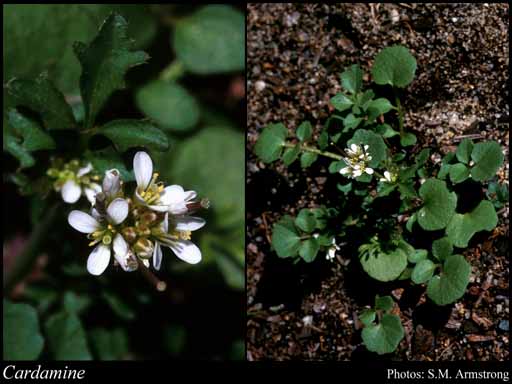- Reference
- Sp.Pl. [Linnaeus] 2:654 (1753)
- Name Status
- Current

Scientific Description
Common name. Bittercresses. Family Brassicaceae.
Habit and leaf form. Herbs. Annual, or perennial. Leaves basal and cauline. Plants with a basal concentration of leaves, or with neither basal nor terminal concentrations of leaves. Stem internodes usually flaccid. To 0.01–0.5 m high. Helophytic and mesophytic. Leaves minute to medium-sized; alternate; spiral; ‘herbaceous’; petiolate to sessile; sheathing to non-sheathing; foetid, or without marked odour; more or less compound, or simple; epulvinate; commonly compound and pinnate; imparipinnate. Leaf blades when simple, dissected to entire; pinnately veined; cross-venulate; of cauline leaves often auriculate. Leaves without stipules. Leaf blade margins entire, or serrate, or dentate. Leaves without a persistent basal meristem. Leaf anatomy. Hairs present, or absent (usually); glandular hairs absent; complex hairs absent. Branched hairs absent. Extra-floral nectaries absent.
Reproductive type, pollination. Fertile flowers hermaphrodite. Unisexual flowers absent. Plants hermaphrodite.
Inflorescence and flower features. Flowers aggregated in ‘inflorescences’; in racemes (usually), or in corymbs. The terminal inflorescence unit racemose. Inflorescences usually many-flowered. Flowers pedicellate; ebracteate; ebracteolate; minute to medium-sized; more or less regular, or somewhat irregular. The floral asymmetry involving the perianth. Flowers 2 merous; cyclic. Floral receptacle with neither androphore nor gynophore. Free hypanthium absent. Hypogynous disk present; of separate members. Perianth with distinct calyx and corolla; 8; 3 -whorled (K 2+2, C 4). Calyx present; 4; 2 -whorled; polysepalous; somewhat spreading, or erect; decussate; regular. Corolla present; 4; 1 -whorled; alternating with the calyx; polypetalous; imbricate, or contorted; regular; white, or pink, or purple. Petals clawed. Androecial members definite in number. Androecium 4, or 6. Androecial members branched (in that the whorl of 4 is derived from only 2 primordia); free of the perianth; all equal, or markedly unequal; free of one another; 2 -whorled (2+4), or 1 -whorled. Androecium exclusively of fertile stamens. Stamens 4, or 6; tetradynamous (where 6 stamens), or not didynamous, not tetradynamous; all more or less similar in shape; hypogynous, on receptacle, outer stamens lateral. Filaments not appendiculate. Anthers basifixed; non-versatile; dehiscing via longitudinal slits; introrse; unilocular to bilocular; tetrasporangiate; appendaged, or unappendaged. Pollen shed as single grains. Gynoecium 2 carpelled. The pistil 2 celled. Gynoecium syncarpous; eu-syncarpous; superior. Ovary plurilocular; 2 locular. Locules secondarily divided by ‘false septa’. Gynoecium transverse. Ovary sessile. Gynoecium non-stylate (apparently), or stylate. Styles 1; apical. Stigmas 1; commissural; slightly 2 - lobed, or 1 - lobed; capitate. Placentation parietal. Ovules (1–)3–50 per locule; with ventral raphe; non-arillate; anatropous.
Fruit and seed features. Fruit (8–)10–45 mm long; non-fleshy; dehiscent (valves released suddenly from the base upwards ejecting the seeds, valves spiral at dehiscence); a siliqua. Capsules valvular. Dispersal unit the mericarp. Fruit 20–100 seeded (‘many’). Seeds 10–50 per locule (to ‘many’). Seed rows per locule 1. Seeds scantily endospermic, or non-endospermic; not mucous; compressed; small to medium sized; winged (nearly always, narrowly), or wingless. Embryo well differentiated. Cotyledons 2; flat; accumbent. Embryo bent.
Physiology, biochemistry. Mustard-oils present.
Special features. Replum present and complete; broad. Fruit bilaterally compressed to terete. The inner (lateral) pair of sepals not noticeably saccate (or scarcely so). Petals not peculiarly elongated as in Stenopetalum. Nectariferous glands lateral and median. Valves of the fruit neither winged nor keeled; without conspicuous longitudinal veins.
Etymology. From the Greek for "heart" and "to subdue", on account of its stomachic qualities.